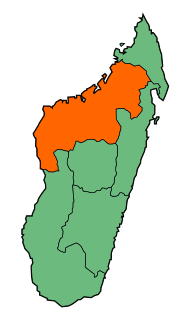
Madagascar is a large island in the Indian Ocean off the eastern coast of southern Africa, east of Mozambique. It has a total area of 587,040 square kilometres (226,660 sq mi) with 581,540 square kilometres (224,530 sq mi) of land and 5,500 square kilometres (2,100 sq mi) of water. Madagascar is the fourth largest island and the 2nd largest island country in the world. The highest point is Maromokotro, in the Tsaratanana Massif region in the north of the island, at 2,876 metres (9,436 ft). The capital Antananarivo is in the Central Highlands near the centre of the island. It has the 25th largest Exclusive Economic Zone of 1,225,259 km2 (473,075 sq mi). Madagascar is 400 kilometres east of mainland Africa.

Mahajanga was a former province of Madagascar that had an area of 150,023 km². It had a population of 1,896,000 (2004). Its capital was Mahajanga, the second largest city in Madagascar.
Takhtajania is a genus of flowering plants of the family Winteraceae, which contains a single species, Takhtajania perrieri. It is endemic to Madagascar.

The Madagascar subhumid forests are a tropical moist broadleaf forest ecoregion that covers most of the Central Highlands of the island of Madagascar. They are included in the WWF's Global 200 list of outstanding ecoregions. Most of the original habitats have been lost due to human pressure.
Anomostachys is a plant genus of the family Euphorbiaceae first described as a genus in 1951. It contains one known species, Anomostachys lastellei, endemic to Madagascar.

Isalo National Park is a National Park in the Ihorombe Region of Madagascar, in the southwestern corner of the Province of Fianarantsoa. The closest town is Ranohira, and the closest cities are Toliara and Ihosy. It is a sandstone landscape that has been dissected by wind and water erosion into rocky outcrops, plateaus, extensive plains and up to 200 m (660 ft) deep canyons. There are permanent rivers and streams as well as many seasonal watercourses. Elevation varies between 510 and 1,268 m.
Xyloolaena is a genus within Sarcolaenaceae family.
Podocarpus madagascariensis is a species of conifer in the family Podocarpaceae. It is found only in Madagascar.
Melanophylla alnifolia is a species of plant in the Torricelliaceae family. It is endemic to eastern Madagascar. Its natural habitat is tropical moist lowland and montane forests. It is threatened by habitat loss.
Grangeopsis is a genus of flowering plants in the family Asteraceae.
Cathariostachys madagascariensis, the Madagascar giant bamboo or volohosy in Malagasy language, is a bamboo species found in Madagascar.

Cedrelopsis grevei, also known as katrafay or kathrafay, is an endemic bush tree from Madagascar.

Dilobeia thouarsii is a species of tree in the family Proteaceae. It is endemic to Madagascar. The specific epithet honours French botanist Louis-Marie Aubert du Petit-Thouars. The leaves are used in traditional Malagasy medicine to treat wounds and bacterial skin infections.
Chapelieria is a monotypic genus of flowering plants in the family Rubiaceae. The genus contains only one species, viz. Chapelieria madagascariensis, which is endemic to Madagascar.

Cinnamosma fragrans is a species of flowering plant in the family Canellaceae. It is endemic to Madagascar, where it is commonly known as saro.
Cinnamosma macrocarpa is a species of flowering plant in the family Canellaceae. It is endemic to Madagascar.
Cinnamosma madagascariensis is a species of flowering plant in the family Canellaceae. It is endemic to Madagascar., where it is known as sakaihazo.

Brexia is a plant genus assigned to the Celastraceae. It is a dense evergreen shrub or small tree of usually around 5 m high, with alternately set, simple, leathery leaves with a short leaf stem and lanceolate to inverted egg-shaped leaf blades. The pentamerous flowers occur in cymes. The petals are greenish white, the samens are alternating with wide, incised staminodes. The superior ovary develops in a long ribbed fruit. Brexia naturally grows on the coast of East Africa, on Madagascar, the Comoros and Seychelles. Opinions differ about the number of species in Brexia. Sometimes the genus is regarded monotypic, B. madagascariensis being a species with a large variability, but other authors distinguish as many as twelve species. Common names for B. madagascariensis include jobiapototra, tsimiranjana, tsivavena, vahilava, voalava, voankatanana, voantalanina, voatalanina and votalanina, and mfukufuku (Swahili), mfurugudu and bwa kato (Seychelles).

Uapaca bojeri, or tapia, is a tree species endemic to Madagascar. A characteristic element of the Madagascan flora, it occurs in the central highlands, where it dominates a type of sclerophyllous forest or woodland. Tapia forest has a high ecological value due to the fauna and flora it harbours, and is of economic interest to the local population, e.g. for collection of tapia fruits, firewood, mushrooms or wild silkworms, and hunting. Local impact through fire and cutting is seen as a form of sustainable use however tapia woodlands are now found only in scattered, isolated stands totaling at most 132,255 ha. Native woody vegetation of the central highlands is increasingly replaced by grasslands, primarily due to increased fire frequency as areas are burned annually.
Abrus madagascariensis is a plant in the legume family Fabaceae, native to Madagascar. It grows as a herb, shrub or liana.









